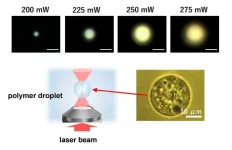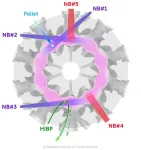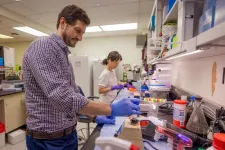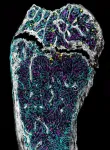(Press-News.org) In a pooled analysis of three clinical trials, acupuncture significantly reduced hot flashes and other hormonal side effects of endocrine therapy taken by women with breast cancer. The analysis of data from the United States, China, and South Korea is published by Wiley online in CANCER, a peer-reviewed journal of the American Cancer Society.
Endocrine therapy, which blocks hormone signaling that drives some forms of breast cancer, can be a life-saving treatment, but up to 80% of patients who take it experience hot flashes—a sudden, temporary sensation of body warmth, flushing, and sweating—and other side effects. Many patients who experience these symptoms discontinue endocrine therapy, which can put them at an elevated risk of cancer progression and death.
Other medications can reduce hot flashes, but they come with their own unpleasant side effects. Studies have evaluated the impact of acupuncture on hot flashes in women with early breast cancer undergoing endocrine therapy, with mixed results.
To provide more information about acupuncture’s potential, investigators conducted a coordinated, multinational project consisting of three independent randomized controlled trials in the United States, China, and South Korea that used the same eligibility criteria, acupuncture protocol, and study measures.
A total of 158 women with stage 0–III breast cancer were randomized to immediate acupuncture (IA) or delayed acupuncture control (DAC). IA participants received acupuncture twice a week for 10 weeks and were followed for an additional 10 weeks without acupuncture. DAC participants received usual care for 10 weeks, then crossed over to acupuncture with a reduced intensity (once per week) for 10 weeks. Standardized clinical questionnaires were used to assess hormonal symptoms—including hot flashes, night sweats, vaginal dryness, and joint pain—as well as quality of life related to physical well-being, functional well-being, emotional well-being, and social/family well-being.
At week 10 from the start of the trials, IA participants’ questionnaire scores reflected significant lessening of symptoms compared with DAC participants. Responses indicated that 64% of people in the IA group reported improvements in the number and severity of their hot flashes, compared with 18% in the DAC group. IA participants also reported greater improvements in quality of life compared with DAC participants.
Between week 10 and week 20, scores did not change significantly for IA participants. DAC participants who received weekly acupuncture during this time had significant improvements in symptom scores relative to week 10. There were no acupuncture-related side effects reported by any of the participants.
“By managing side effects, our approach makes it easier for patients to continue their prescribed medication, which has the potential to reduce the risk of cancer recurrence and improve long-term outcomes for breast cancer survivors,” said lead author Weidong Lu, MB, MPH, PhD, of the Dana-Farber Cancer Institute. “In practice, patients interested in using acupuncture for this purpose might begin with a short trial period to assess their response to the treatment, particularly in terms of reduction in hot flashes and other symptoms. If the trial period yields positive results, patients may then engage in a long-term program, receiving regular acupuncture sessions throughout the duration of their anti-hormonal medication regimen.”
Additional information
NOTE: The information contained in this release is protected by copyright. Please include journal attribution in all coverage. A free abstract of this article will be available via the CANCER Newsroom upon online publication. For more information or to obtain a PDF of any study, please contact: Sara Henning-Stout, newsroom@wiley.com
Full Citation:
“Acupuncture for Hot Flashes in Hormone Receptor-Positive Breast Cancer, A Pooled Analysis of Individual Patient Data from Parallel Randomized Trials.” Weidong Lu, Anita Giobbie-Hurder, Anna Tanasijevic, Sylvia Baedorf Kassis, Sung Hwan Park, Young Ju Jeong, Im Hee Shin, Chang Yao, Hyun Jung Jung, Zhiyuan Zhu, Chao Bao, Ting Bao, EunMee Yang, Barbara E. Bierer, and Jennifer A. Ligibel. CANCER; Published Online: June 24, 2024 (DOI: 10.1002/cncr.35374).
URL Upon Publication: http://doi.wiley.com/10.1002/cncr.35374
Author Contact: John W. Noble, Media Relations Manager at the Dana-Farber Cancer Institute, at johnw_noble@dfci.harvard.edu or +1 703-407-9416.
About the Journal
CANCER is a peer-reviewed publication of the American Cancer Society integrating scientific information from worldwide sources for all oncologic specialties. The objective of CANCER is to provide an interdisciplinary forum for the exchange of information among oncologic disciplines concerned with the etiology, course, and treatment of human cancer. CANCER is published on behalf of the American Cancer Society by Wiley and can be accessed online. Follow CANCER on Twitter @JournalCancer and Instagram @ACSJournalCancer, and stay up to date with the American Cancer Society Journals on LinkedIn.
About Wiley
Wiley is a knowledge company and a global leader in research, publishing, and knowledge solutions. Dedicated to the creation and application of knowledge, Wiley serves the world’s researchers, learners, innovators, and leaders, helping them achieve their goals and solve the world's most important challenges. For more than two centuries, Wiley has been delivering on its timeless mission to unlock human potential. Visit us at Wiley.com. Follow us on Facebook, Twitter, LinkedIn and Instagram.
END
Can acupuncture lessen hot flashes and other side effects of anti-hormonal breast cancer therapy?
A pooled analysis of three randomized trials from different countries reveals significant benefits to this approach
2024-06-24
ELSE PRESS RELEASES FROM THIS DATE:
Novel application of optical tweezers: colorfully showing molecular energy transfer
2024-06-24
A novel technique with potential applications for fields such as droplet chemistry and photochemistry has been demonstrated by an Osaka Metropolitan University-led research group.
Professor Yasuyuki Tsuboi of the Graduate School of Science and the team investigated Förster resonance energy transfer (FRET), a phenomenon seen in photosynthesis and other natural processes where a donor molecule in an excited state transfers energy to an acceptor molecule.
Using dyes to mark the donor and acceptor molecules, the team set out to see if FRET could be controlled by the intensity of an optical force, in this case a laser beam. By focusing a laser beam on an isolated polymer droplet, the team ...
Discovery of spontaneous inflow and outflow states of high-temperature plasma by energetic ions
2024-06-24
Background
In the realm of fusion research, the control of plasma density, temperature, and heating is crucial for enhancing reactor performance. Effective confinement of plasma particles and heat, especially maintaining high density and temperature at the core where fusion occurs is essential. In the Large Helical Device (LHD)*1, challenges persist as the electron density profile often remains flat or even depressed at the center, complicating effort to sustain high central density.
Results
The LHD is equipped with five neutral beam (NB) injectors*3 for plasma ...
Tax the rich, say a majority of adults across 17 G20 countries surveyed
2024-06-24
A new survey of adult citizens in 18 of the world’s largest economies has revealed majority support for tax reforms and broader political and economic reform. (Not all questions were asked in China, as indicated when findings reference 17 G20 countries.)
Around two-thirds (68%) of citizens across 17[1] G20 countries surveyed back a wealth tax on wealthy people as a means of funding major changes to our economy and lifestyle, with only 11% opposed, while 70% support higher rates of income tax on wealthy people, and 69% favour higher tax rates on large businesses, according to the survey conducted by Ipsos.
Support for a wealth tax on ...
Semaglutide leads to greater weight loss in women than men with HF, improves HF symptoms in both sexes
2024-06-23
Key Findings:
Weight Loss: Women lost 9.6% of their body weight on average with semaglutide, compared with 7.2% in men, marking a significant difference.
Symptom Improvement: Both sexes saw notable improvements in HF symptoms, physical limitations, and exercise function.
Heart Failure Benefits Beyond Weight Loss: Despite greater weight loss in women, the improvement in HF symptoms was similar between sexes, suggesting semaglutide's heart failure benefits may be, in part, independent of weight loss.
WASHINGTON (June 23, 2024) – Semaglutide, a medication initially developed for ...
12.5, the 1st Impact Factor of COMMTR released!
2024-06-22
Clarivate released the first Impact Factor (2023 IF) of Communications in Transportation Research (COMMTR) on June 20, 2024. COMMTR's 2023 IF is 12.5, ranking in Top 1 (1/57, Q1) among all journals in "TRANSPORTATION" category, and its 2023 CiteScore is 15.2 (top 5%) in Scopus database.
We would like to express our sincere appreciation for the authors, reviewers, readers, editorial board members for helping to make the journal a success. We welcome your continued readership and article ...
Circadian clock impact on cluster headaches funded by $2.4M NIH grant for UTHealth Houston research
2024-06-21
The link between severe headache disorders headaches and the body’s circadian clock in pain timing and thresholds will be studied with a $2.4 million grant from the National Institute of Neurological Disorders and Stroke (NINDS) to UTHealth Houston researchers.
The research is led by two faculty members of McGovern Medical School at UTHealth Houston: Mark Burish, MD, PhD, associate professor in the Vivian L. Smith Department of Neurosurgery, and Seung-Hee Yoo, PhD, associate professor in the Department of Biochemistry and Molecular Biology.
The study builds on earlier research by Burish and Yoo, funded by the Will Erwin Headache Research Foundation and published ...
Study identifies first drug therapy for sleep apnea
2024-06-21
Researchers at University of California San Diego School of Medicine and international collaborators have led a worldwide, advanced study demonstrating the potential of tirzepatide, known to manage type 2 diabetes, as the first effective drug therapy for obstructive sleep apnea (OSA), a sleep-related disorder characterized by repeated episodes of irregular breathing due to complete or partial blockage of the upper airway.
The results, published in the June 21, 2024 online edition of New England Journal of Medicine, highlight the treatment’s potential to improve the quality of life for millions around the world affected by OSA.
“This study marks a significant ...
How old is your bone marrow?
2024-06-21
Our bone marrow—the fatty, jelly-like substance inside our bones—is an unseen powerhouse quietly producing 500 billion new blood cells every day. That process is driven by hematopoietic stem cells that generate all of the various types of blood cells in our bodies and regenerating themselves to keep the entire assembly line of blood production operating smoothly.
As with any complex system, hematopoietic stem cells lose functionality as they age—and, in the process, contribute to the risk of serious diseases, including blood cancers. We know that the risk of developing aging-associated diseases is different among different individuals. ...
Boosting biodiversity without hurting local economies
2024-06-21
DURHAM, N.C. -- Protected areas, like nature reserves, can conserve biodiversity without harming local economic growth, countering a common belief that conservation restricts development. A new study outlines what is needed for conservation to benefit both nature and people.
Conservation zones aim to preserve biodiversity, protect endangered species, and maintain natural habitats. “There’s long been uncertainty about the economic tradeoffs,” said Binbin Li, associate professor of environmental science at Duke Kunshan University, and lead author ...
ChatGPT is biased against resumes with credentials that imply a disability — but it can improve
2024-06-21
While seeking research internships last year, University of Washington graduate student Kate Glazko noticed recruiters posting online that they’d used OpenAI’s ChatGPT and other artificial intelligence tools to summarize resumes and rank candidates. Automated screening has been commonplace in hiring for decades. Yet Glazko, a doctoral student in the UW’s Paul G. Allen School of Computer Science & Engineering, studies how generative AI can replicate and amplify real-world biases — such as those against disabled people. How might such a system, she wondered, rank resumes that implied someone had a disability?
In ...
LAST 30 PRESS RELEASES:
Injectable breast ‘implant’ offers alternative to traditional surgeries
Neuroscientists devise formulas to measure multilingualism
New prostate cancer trial seeks to reduce toxicity without sacrificing efficacy
Geometry shapes life
A CRISPR screen reveals many previously unrecognized genes required for brain development and a new neurodevelopmental disorder
Hot flush treatment has anti-breast cancer activity, study finds
Securing AI systems against growing cybersecurity threats
Longest observation of an active solar region
Why nail-biting, procrastination and other self-sabotaging behaviors are rooted in survival instincts
Regional variations in mechanical properties of porcine leptomeninges
Artificial empathy in therapy and healthcare: advancements in interpersonal interaction technologies
Why some brains switch gears more efficiently than others
UVA’s Jundong Li wins ICDM’S 2025 Tao Li Award for data mining, machine learning
UVA’s low-power, high-performance computer power player Mircea Stan earns National Academy of Inventors fellowship
Not playing by the rules: USU researcher explores filamentous algae dynamics in rivers
Do our body clocks influence our risk of dementia?
Anthropologists offer new evidence of bipedalism in long-debated fossil discovery
Safer receipt paper from wood
Dosage-sensitive genes suggest no whole-genome duplications in ancestral angiosperm
First ancient human herpesvirus genomes document their deep history with humans
Why Some Bacteria Survive Antibiotics and How to Stop Them - New study reveals that bacteria can survive antibiotic treatment through two fundamentally different “shutdown modes”
UCLA study links scar healing to dangerous placenta condition
CHANGE-seq-BE finds off-target changes in the genome from base editors
The Journal of Nuclear Medicine Ahead-of-Print Tip Sheet: January 2, 2026
Delayed or absent first dose of measles, mumps, and rubella vaccination
Trends in US preterm birth rates by household income and race and ethnicity
Study identifies potential biomarker linked to progression and brain inflammation in multiple sclerosis
Many mothers in Norway do not show up for postnatal check-ups
Researchers want to find out why quick clay is so unstable
Superradiant spins show teamwork at the quantum scale
[Press-News.org] Can acupuncture lessen hot flashes and other side effects of anti-hormonal breast cancer therapy?A pooled analysis of three randomized trials from different countries reveals significant benefits to this approach






